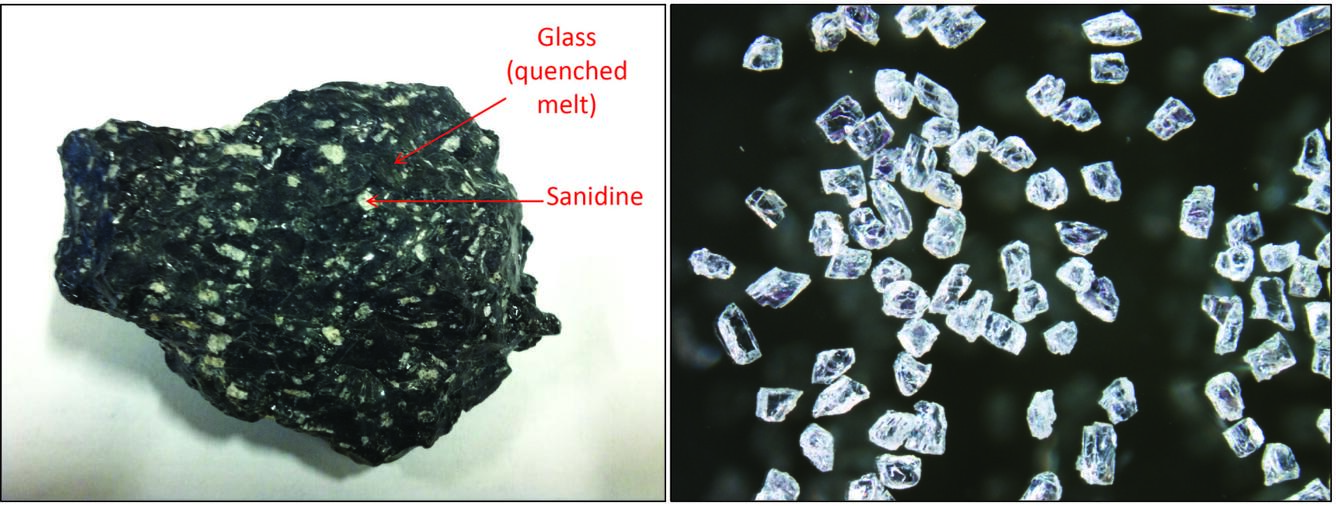Sanidine: Nature’s record of Yellowstone’s dynamic past
Geologists look for big things in small packages. In Yellowstone, information about some of the biggest volcanic eruptions are hidden in the smallest crystals!
Yellowstone Caldera Chronicles is a weekly column written by scientists and collaborators of the Yellowstone Volcano Observatory. This week's contribution is from Mark Stelten, research geologist with the U.S. Geological Survey.
Yellowstone National Park and its world-famous hydrothermal system are the result a long and dynamic volcanic history that spans millions of years. Yellowstone’s landscape is a reflection of explosive eruptions that produced large basin-shaped depressions referred to as calderas and viscous rhyolite lava flows that produced the broad plateaus. Over the past 50 years, scientists have been piecing together the volcanic events that have shaped Yellowstone into the natural wonder it is today. Due to this work, we now have a very good understanding of the major events that occurred at Yellowstone and, importantly, we know when these events occurred. This allows us to not only understand how Yellowstone came to be, but also to help anticipate what may happen in the future.
To put together the history of volcanic events at Yellowstone volcanologists turn to a field of science called geochronology, which is the study of Earth’s history from the perspective of time. Geochronologists use radioactive isotopes of various elements contained within earth materials to determine when those materials formed. Most people are familiar with this concept because of carbon dating. However, carbon dating requires carbon-rich material, like dead plant matter or charcoal, and therefore cannot be used on volcanic rocks and minerals that are rich in silica. Fortunately, there are many other elements that can be used to date earth materials—for example, radioactive isotopes of uranium, thorium, samarium, lutecium, potassium, and many more.
Much of our understanding of Yellowstone’s dynamic history is due to geochronologic studies that utilize a millimeter sized, white mineral called sanidine found within the rhyolites of Yellowstone. Sanidine has the ability to record when an eruption occurred due to its high concentration of the element potassium (“K” in the periodic table of elements), which allows scientists to use a technique based on the radioactive decay of potassium to argon (don’t worry, it is very slow and not dangerous!).
Conceptually, this technique works as follows. Sanidine crystallizes from magma at high temperatures and incorporates a significant amount of potassium into its crystal structure. One isotope of potassium, known as 40K, undergoes radioactive decay and converts to an isotope of argon (“Ar” in the periodic table of elements) known as 40Ar. When the magma is still hot and full of thermal energy, the newly produced argon escapes from the sanidine crystal, which means that the radioactive “clock” cannot start when the magma is hot. However, when the magma erupts onto the Earth’s surface and cools, the thermal energy in the system is lost and the argon produced from decay of potassium begins to accumulate in the sanidine crystals. In other words, the radioactive clock starts after the magma is erupted.
Scientists exploit this behavior by extracting sanidine crystals from volcanic rocks and measuring the ratio of potassium (the parent) to argon (the daughter product produced through radioactive decay) in the crystals. This allows the time of eruption to be precisely determined. Performing these analyses on rhyolite samples throughout Yellowstone has allowed scientists to piece together a detailed history of eruptions in theregion. For example, geochronologists have shown that the eruption associated with Yellowstone caldera occurred 631,000 years ago, and since then lava flows erupted within Yellowstone in two phases: from 580,000 to 255,000 years ago, and from 170,000 to 70,000 years ago. These lava flows make up the broad plateaus seen throughout the park.
Researchers are still actively performing geochronologic studies at Yellowstone to improve our understanding of its volcanic history. With advances in technology researchers are now able to determine the eruption ages of volcanic rocks even more precisely than ever before. This allows even more detailed questions to be ask about volcanic processes such as: Do volcanic eruptions tend to cluster in time, or are they separated by long periods of time? What is the duration of a large volcanic eruption?
So, the next time you are in Yellowstone, be sure to take an up-close view of some of the rhyolite lava flows that dominate the area within the caldera—for example, all around the Old Faithful area. The small, white sanidine crystals in these rhyolites tell a big story!
Get Our News
These items are in the RSS feed format (Really Simple Syndication) based on categories such as topics, locations, and more. You can install and RSS reader browser extension, software, or use a third-party service to receive immediate news updates depending on the feed that you have added. If you click the feed links below, they may look strange because they are simply XML code. An RSS reader can easily read this code and push out a notification to you when something new is posted to our site.



